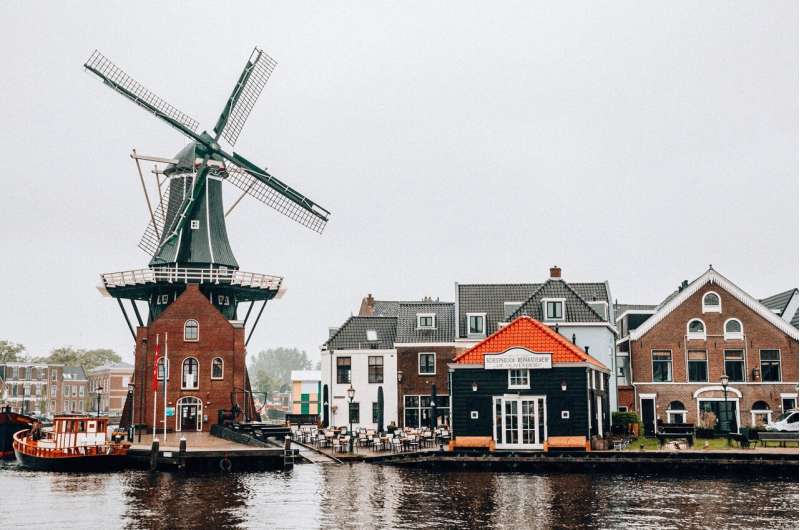
While the rest of the world literally looks up to the Dutch, the tallest members of the loftiest populace on earth insist it’s not easy being big.
So an official study by the Dutch national statistics office finding that they appear to be shrinking might be construed as good news—even if it could threaten the Netherlands’ number one spot.
At a meeting of the Klub Lange Mensen, or Tall People’s Club, the lowlanders say there are drawbacks to towering over most of the rest of humanity.
“I’ve always struggled with my height. When I was 12, I was already the tallest in the class, also taller than my teachers,” club chairman Helen Keuken, 57, tells AFP.
“And when I came in contact with the club it was a revelation. I felt like an outsider and now I belong somewhere,” says Keuken, who is 1.90 metres (six foot three inches) tall.
In a bar in the Dutch town of Aalsmeer near Schiphol airport, members of the club dance and chat over a drink, glad to have a place to gather where they don’t stand out.
Even by Dutch standards they are tall, with male club members needing to measure at least 1.90m and women at least 1.80m (five foot 11).
“We can have a conversation at eye level. You don’t have to bend, you can look straight,” said club secretary Rob Leurs-Kout, an imposing 2.11m tall.
“That’s very nice.”
Many of the members say that being tall in the Netherlands has become “less exceptional” than when they were younger, notwithstanding the study by the national statistics office, CBS.
‘A lot of milk’
Dutch men born in 2001 are 1.829m tall on average, one cm shorter than the generation born in 1980, the CBS says, while women born in 2001 measure on average 1.693m (five foot seven), 1.4cm less than 1980.
Even so, the Dutch remain the world’s tallest—they still surpass on average the men of Montenegro, Estonia and Bosnia and the women of Montenegro, Denmark and Iceland, says the CBS—but that could change.
At the start of the 19th century the Dutch were small by European standards and only started to shoot up in the 1840s, before finally becoming the tallest with the generation born in the 1950s.
The reasons are “very difficult to pinpoint”, says Gert Stulp of the University of Groningen’s faculty of behavioural and social sciences.
“We know if a country gets wealthier with better healthcare and better nutrition and fewer diseases that increases height, as it has done for the Netherlands,” says Stulp, who stands two metres tall.
“Our diets are believed to be one cause, the Dutch drink a lot of milk.”
A widely quoted theory that natural selection is responsible—with taller Dutch people having more children than shorter people, and their children then repeating the pattern—leaves Stulp “not convinced”.
As for the shrinkage? Migration to the Netherlands is one main cause, with people from non-Western backgrounds generally being shorter, both the CBS and Stulp suggested.
‘Downward trend’
But migration doesn’t account for everything, as growth has also “stagnated” among people with both parents born in the Netherlands, and people with both grandparents born in the Netherlands.
Men without a migratory background have not got any taller since 1980, while there was even a “downward trend” among women in that category, the CBS said.
“It might be a signal of increasing inequality, it might also be a signal we… had less healthy food,” says Stulp, with fast food and high-sugar diets particularly to blame.
Humans may also have simply reached a “physiological limit”, with similar levelling off seen in other European countries, he said.
Back at the Klub Lange Mensen, they are not convinced that the Dutch are getting smaller.
“I don’t see that, no,” says Nico Verhoef, 66, who is over two metres tall. “Most people have remained very tall in my view.”
Instead, they are pleased to see how the Netherlands has adapted to its status as world’s tallest nation.
Clothing and shoe shops for tall people have sprung up around the country, while the Dutch even changed building codes to raise minimum ceilings of new houses from 180 cm to 200 cm.
“When I was little, there was only one store in the Netherlands where I used to buy my shoes. Now you have stores with plus sizes everywhere,” Verhoef says.
Members insist the rest of the world have little reason to be jealous.
“I don’t see many benefits,” Verhoef says. “Only if I am in a crowded area—then my wife can find me easily.”

